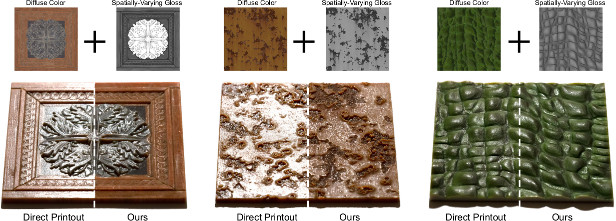Towards Spatially Varying Gloss Reproduction for 3D Printing
ACM Transactions on Graphics (Proc. SIGGRAPH Asia), December 2020

The input to our system is a diffuse color and spatially-varying
gloss. We first reproduce the color using commercial ink-jet printers
(left halves). Next, as a post-processing step we use our custom printer
to jet varnishes that match the input reflectance (right halves).
Abstract
3D printing technology is a powerful tool for manufacturing complex shapes
with high-quality textures. Gloss, next to color and shape, is one of the
most salient visual aspects of an object. Unfortunately, printing a wide
range of spatially-varying gloss properties using state-of-the-art 3D
printers is challenging as it relies on geometrical modifications to
achieve the desired appearance. A common post-processing step is to apply
off-the-shelf varnishes that modify the final gloss. The main difficulty
in automating this process lies in the physical properties of the varnishes
which owe their appearance to a high concentration of large particles and
as such, they cannot be easily deposited with current 3D color printers.
As a result, fine-grained control of gloss properties using today's 3D
printing technologies is limited in terms of both spatial resolution and
the range of achievable gloss.
We address the above limitations and propose new printing hardware based on
piezo-actuated needle valves capable of jetting highly viscous varnishes.
Based on the new hardware setup, we present the complete pipeline for
controlling the gloss of a given 2.5D object, from printer calibration,
through material selection, to the manufacturing of models with
spatially-varying reflectance. Furthermore, we discuss the potential
integration with current 3D printing technology. Apart from being a viable
solution for 3D printing, our method offers an additional and essential
benefit of separating color and gloss fabrication which makes the process
more flexible and enables high-quality color and gloss reproduction.
Paper
Video
Citation
Michal Piovarči, Michael Foshey, Vahid Babaei, Szymon Rusinkiewicz, Wojciech Matusik, and Piotr Didyk.
"Towards Spatially Varying Gloss Reproduction for 3D Printing."
ACM Transactions on Graphics (Proc. SIGGRAPH Asia) 39(6), December 2020.
BibTeX
@article{Piovarči:2020:TSV,
author = "Michal Piovar{\v c}i and Michael Foshey and Vahid Babaei and Szymon
Rusinkiewicz and Wojciech Matusik and Piotr Didyk",
title = "Towards Spatially Varying Gloss Reproduction for {3D} Printing",
journal = "ACM Transactions on Graphics (Proc. SIGGRAPH Asia)",
year = "2020",
month = dec,
volume = "39",
number = "6"
}